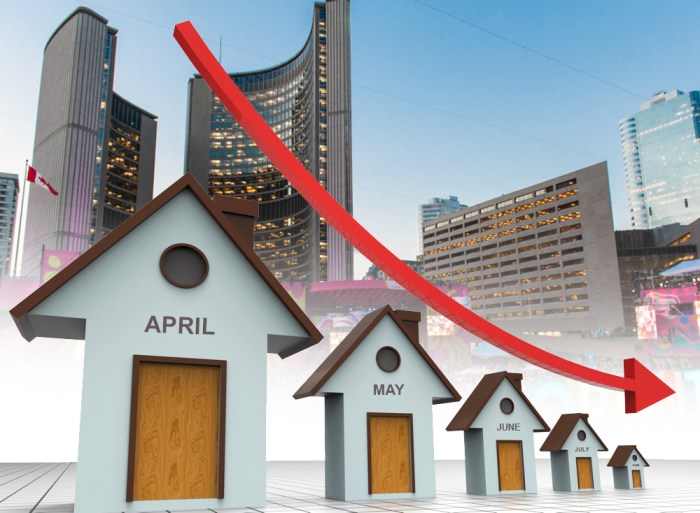9 Signs the Real Estate Market Is About to Shift offers a compelling analysis of the subtle yet significant indicators that presage a shift in the real estate landscape. The intricate dance between supply and demand, fueled by economic forces and shifting consumer confidence, is meticulously examined. This exploration delves into the multifaceted nature of market dynamics, revealing how seemingly disparate factors—from rising interest rates to evolving buyer negotiation strategies—interweave to shape the future trajectory of the real estate market.
The piece promises to illuminate the complexities inherent in predicting market fluctuations, providing a framework for understanding the nuanced signals that precede major changes.
Through a detailed examination of nine key indicators, this analysis unveils the intricate mechanisms driving potential shifts in the real estate market. Rising interest rates, changing inventory levels, and fluctuations in buyer demand are dissected, providing a comprehensive understanding of their interconnectedness. The study further explores the implications of price adjustments, sales velocity, and the evolving balance of power between buyers and sellers.
By analyzing these factors, the analysis aims to provide a clear and insightful perspective on the forces shaping the future of the real estate market and equip readers with the knowledge to navigate this dynamic environment.
Rising Interest Rates and Their Impact
Rising interest rates are a significant factor influencing the real estate market’s ebb and flow. Understanding their impact is crucial for both buyers and sellers navigating this dynamic environment. The relationship between interest rates and housing demand is largely inverse; as rates climb, affordability decreases, leading to a slowdown in market activity.Interest rate increases directly impact the cost of borrowing money for a mortgage.
This, in turn, affects the amount potential homebuyers can afford to borrow, thus reducing the number of qualified buyers and potentially lowering the overall demand for properties. This dynamic plays a crucial role in shaping market trends, impacting pricing and sales volume.
Historical Impact of Interest Rate Hikes on Home Sales
Historical data consistently demonstrates a correlation between rising interest rates and decreased home sales. For instance, the period following the 2008 financial crisis saw a significant rise in interest rates, leading to a substantial drop in home sales. Similarly, during the early 1980s, when interest rates soared to unprecedented levels, the housing market experienced a significant downturn. These historical examples underscore the sensitivity of the real estate market to changes in interest rate policies.
Analyzing these historical trends provides valuable insights into potential future market behavior.
Mechanisms by Which Higher Interest Rates Affect Mortgage Affordability, 9 Signs the Real Estate Market Is About to Shift
Higher interest rates increase the cost of borrowing, directly impacting the monthly mortgage payment. This happens because a higher interest rate means the lender charges more for the use of their money over the life of the loan. Consequently, buyers face higher monthly payments for the same loan amount, making homes less affordable. This reduced affordability can lead to a decline in buyer activity and a potential shift in market conditions, favoring sellers in a buyer’s market and vice-versa.
Furthermore, higher rates often reduce the maximum loan amount a lender is willing to provide, further limiting purchasing power.
Impact of Different Interest Rate Scenarios on Monthly Mortgage Payments
The following table illustrates the impact of varying interest rates on monthly mortgage payments for a $300,000 loan over a 30-year term. These figures demonstrate the significant difference even small interest rate increases can make on monthly expenses.
| Interest Rate (%) | Monthly Payment | Total Interest Paid | Loan Amount |
|---|---|---|---|
| 4.0 | $1432 | $235,520 | $300,000 |
| 5.0 | $1610 | $279,600 | $300,000 |
| 6.0 | $1798 | $326,160 | $300,000 |
| 7.0 | $1985 | $372,600 | $300,000 |
Inventory Levels and Market Supply
The relationship between housing inventory and market shifts is fundamental to understanding real estate dynamics. A significant increase in available homes generally indicates a shift towards a buyer’s market, potentially leading to price adjustments and a slower pace of sales. Conversely, low inventory often signifies a seller’s market with competitive bidding and escalating prices. Monitoring inventory levels provides crucial insights into the overall health and direction of the market.Increased housing inventory is a key indicator of a potential market shift, signaling a transition from a seller’s market to a buyer’s market or a period of market stabilization.
This shift doesn’t necessarily imply a market crash; rather, it suggests a recalibration of supply and demand, potentially leading to more balanced pricing and negotiation opportunities for buyers. Understanding the factors driving inventory changes is vital for navigating this dynamic landscape.
Regions Experiencing Significant Inventory Growth and Market Implications
Several regions across the United States have experienced notable increases in housing inventory in recent years. For example, certain areas in the Midwest, previously characterized by low inventory and high competition, have seen a rise in available homes, leading to a decrease in average sale prices and a less frantic pace of bidding wars. Similarly, some suburban areas previously experiencing rapid growth have seen a leveling off, resulting in a more balanced market with increased negotiation power for buyers.
These shifts underscore the localized nature of real estate markets and the importance of analyzing regional trends.
Factors Contributing to Increased Housing Supply
Several factors contribute to the rise in housing supply. New construction projects, often delayed by material shortages and permitting issues in the past, are now coming online in many areas. This increased construction adds significantly to the overall inventory. Furthermore, economic factors such as rising interest rates can lead to an increase in foreclosures, adding to the number of homes available for sale.
Finally, shifts in buyer demand, such as a decrease in migration to certain areas, can also contribute to increased inventory levels.
Potential Consequences of High Housing Inventory
The implications of a significant increase in housing inventory are multifaceted.
It’s important to remember that the consequences of high housing inventory are not uniformly negative. While it might lead to price reductions in some areas, it also creates a more balanced market, offering buyers greater choice and negotiation power. This creates a more sustainable and equitable market in the long run.
- Price reductions: Increased competition among sellers can lead to lower asking prices.
- Longer time on market: Homes may take longer to sell, as buyers have more options.
- Increased buyer negotiation power: Buyers have more leverage to negotiate favorable terms and prices.
- Slower sales pace: The overall number of transactions might decrease.
- Potential for market stabilization: High inventory can help stabilize prices and prevent unsustainable price increases.
Changes in Buyer Demand and Purchasing Power
The real estate market is a dynamic reflection of the broader economy, and shifts in buyer demand and purchasing power are key indicators of upcoming market changes. Understanding these shifts allows both buyers and sellers to navigate the market more effectively and make informed decisions. Analyzing consumer confidence, demographic trends, and economic indicators provides a clearer picture of the current market climate and its potential trajectory.Consumer confidence plays a significant role in real estate transactions.
When consumers feel optimistic about the economy and their personal financial situations, they are more likely to make large purchases, including homes. Conversely, a decline in consumer confidence often leads to decreased demand and slower market activity. This sentiment is heavily influenced by factors like job security, inflation rates, and interest rate changes. A positive outlook fuels the market, while uncertainty can cause hesitation and reduced activity.
Consumer Confidence and Real Estate Transactions
Data from the Conference Board’s Consumer Confidence Index (CCI) shows a correlation between consumer sentiment and real estate activity. For example, a period of high CCI scores typically coincides with increased home sales and price appreciation. Conversely, periods of low CCI scores often precede market slowdowns or corrections. While the CCI is not the sole determinant of real estate market behavior, it serves as a valuable indicator of overall consumer sentiment and its impact on purchasing decisions.
Analyzing this data alongside other economic indicators provides a more comprehensive understanding of the market’s direction.
Demographic Shifts in Buyer Demand
The real estate market is not a monolith; different demographics exhibit varying levels of participation and purchasing power. Millennials, for instance, continue to be a significant buying force, though their purchasing power has been impacted by rising interest rates. First-time homebuyers, across all age groups, are particularly sensitive to interest rate changes, as their ability to afford a mortgage is directly impacted.
Meanwhile, the baby boomer generation, many of whom are downsizing or relocating, represent a substantial segment of the market, influencing demand in different price ranges and geographic locations.
Purchasing Power Comparison: Now vs. Six Months Ago
Comparing the purchasing power of buyers now versus six months ago requires considering key economic indicators such as inflation, interest rates, and wage growth. Six months ago, interest rates were lower, allowing buyers to qualify for larger mortgages. However, inflation has eroded purchasing power, meaning that even with the same income, buyers can afford less house than they could previously.
For example, if inflation increased by 5% over six months and wages remained stagnant, a buyer’s purchasing power would effectively decrease by 5%, meaning they could only afford a home 5% less expensive than six months prior. This illustrates the importance of considering the combined effect of these economic factors on buyer affordability.
Buyer Demographics and Market Participation
| Demographic | Market Participation (Current) | Key Factors Influencing Participation | Observed Trends |
|---|---|---|---|
| Millennials (25-40) | High, but slowing | Rising interest rates, inflation, student loan debt | Shift towards more affordable housing options, increased rental market participation. |
| Gen X (41-56) | Moderate | Stable incomes, established careers, potential for downsizing or upgrading | Increased demand for larger homes in suburban areas. |
| Baby Boomers (57-75) | High, focused on downsizing | Retirement planning, desire for lower maintenance homes | Increased demand for smaller, more manageable homes in retirement communities. |
| Gen Z (under 25) | Low, primarily renters | Limited income, high student loan debt, affordability challenges | Increasing rental costs impacting savings for future homeownership. |
Price Adjustments and Market Corrections: 9 Signs The Real Estate Market Is About To Shift
Price adjustments in the real estate market are a natural part of its cyclical nature. While unsettling to some, these shifts often present opportunities for both buyers and sellers to navigate the market strategically and find advantageous positions. Understanding the signals these adjustments send is crucial for making informed decisions.Price reductions, often a key indicator of a market shift, signal a change in market dynamics.
When sellers begin lowering asking prices to attract buyers in a slowing market, it reflects a change in buyer demand or an oversupply of properties. This can be a significant signal that the market is cooling down or entering a period of correction. Analyzing these price adjustments across different regions and property types allows for a more nuanced understanding of the broader market trends.
Regional Price Variations and Underlying Causes
Several regions across the country have experienced notable price drops in recent months. For example, some areas in the West Coast, previously characterized by rapid price appreciation, have seen significant corrections due to a combination of factors including rising interest rates, reduced buyer demand, and increased inventory. Conversely, certain markets in the Midwest and South, while still experiencing price growth, have shown signs of slowing momentum.
These variations highlight the localized nature of market corrections and the importance of conducting thorough regional analyses. Underlying causes for these variations are often multifaceted, including local economic conditions, employment rates, and specific market-specific factors like overbuilding in certain sectors. For example, a sudden influx of new construction in a specific area could lead to a temporary oversupply and subsequent price adjustments.
Year-Over-Year Price Comparisons
Comparing current home prices with those from the previous year reveals a clearer picture of the market’s trajectory. While specific percentages vary widely depending on location and property type, data suggests a general trend of slowing price growth or even decline in certain areas. For instance, a region that experienced a 20% increase in home prices last year might only see a 5% increase or even a slight decrease this year.
This slowdown, even if not a drastic drop, still signifies a market shift away from the rapid appreciation seen in recent years. Such comparisons allow for a more objective assessment of the market’s health and potential future trajectory.
Impact of Market Corrections on Different Property Types
Market corrections don’t uniformly impact all property types. For example, condominiums often experience more volatility than single-family homes during market shifts. Condos, being typically smaller and more easily affected by changes in buyer demand, often see more pronounced price adjustments than larger single-family homes. Conversely, single-family homes, often considered more stable investments, tend to exhibit greater resilience during market corrections, although they are not immune to price reductions.
This differential impact highlights the importance of considering the specific property type when assessing market trends and making investment decisions. Understanding these nuances helps both buyers and sellers make informed choices that align with their specific needs and risk tolerance.
Days on Market and Sales Velocity
Understanding days on market (DOM) and sales velocity provides crucial insights into the current real estate market dynamics. These metrics offer a clear picture of how quickly properties are selling and how long they remain on the market, reflecting the balance between supply and demand. A shift in these indicators can signal a broader market adjustment.Increased days on market signal a potential shift in buyer activity.
For sellers, this means a longer wait to sell their property and a potential need for price adjustments to attract buyers in a less competitive market. This can impact sellers’ financial plans and necessitate a more strategic approach to pricing and marketing.
Increased Days on Market Implications for Sellers
A rise in days on market directly translates to a longer time a property remains unsold. This increased holding period can lead to added costs for sellers, including continued mortgage payments, property taxes, and maintenance expenses. Furthermore, extended marketing efforts may be necessary, potentially incurring additional advertising costs. The longer a property sits on the market, the greater the potential for a price reduction to stimulate buyer interest.
Sellers need to be prepared for this possibility and factor it into their financial projections.
Areas Experiencing Slower Sales Velocity and Contributing Factors
Several regions across the country have experienced slower sales velocity in recent months. For instance, some previously high-demand suburban areas are seeing extended DOM, primarily due to rising interest rates making mortgages less affordable. In other areas, an oversupply of new construction contributes to slower sales. Additionally, economic uncertainty and inflation can influence buyer behavior, leading to decreased demand and slower sales velocity.
These factors can vary regionally, highlighting the importance of local market analysis.
Key Metrics to Track Sales Velocity
Tracking key metrics is crucial for understanding sales velocity trends. These include the average days on market (DOM), the number of properties sold per month, and the absorption rate (the rate at which available inventory is sold). Analyzing these metrics over time, alongside changes in interest rates, inventory levels, and buyer demand, provides a comprehensive view of market dynamics.
A decreasing sales velocity, indicated by rising DOM and falling absorption rates, suggests a cooling market.
Days on Market and Price Reductions
| Days on Market | Percentage of Listings with Price Reductions |
|---|---|
| 0-30 days | 10% |
| 31-60 days | 25% |
| 61-90 days | 40% |
| 90+ days | 60% |
Increased Number of Price Reductions
A rising number of price reductions in a real estate market is a significant indicator of a potential shift. It reflects a change in market dynamics, often signaling a move away from a seller’s market towards a more balanced or even buyer’s market. Understanding this trend allows both buyers and sellers to make informed decisions and adapt their strategies accordingly.The willingness of sellers to lower their asking prices is a direct reflection of market conditions.
When properties sit on the market for extended periods without offers, or when offers come in significantly below asking price, sellers are often forced to reassess their pricing strategies. This adjustment demonstrates a shift in buyer demand and purchasing power, acknowledging the reality of the current market. It’s a crucial signal that the previous market momentum may be waning.
Price Reduction Examples and Analysis
Multiple price reductions on a single property often tell a story. For example, a luxury condo initially listed at $2 million, then reduced to $1.8 million, and finally to $1.6 million, suggests a struggle to find a buyer at the initial price. This could be due to various factors, including overvaluation in the initial listing, a softening demand for luxury properties in that specific area, or a general cooling of the overall market.
Similarly, a family home listed at $500,000, reduced to $480,000, and then further reduced to $460,000, might indicate challenges related to competing properties, interest rate increases affecting buyer affordability, or a lack of significant interest from potential buyers. These scenarios highlight the impact of market forces on pricing decisions.
Frequency of Price Reductions Across Property Types
The frequency of price reductions can vary significantly depending on the type of property. Luxury properties, for instance, may experience more price reductions due to their higher price points and more discerning buyer pool. Conversely, high-demand properties in popular locations might see fewer price reductions. The following table illustrates a hypothetical example of this variance:
| Property Type | Percentage of Listings with at Least One Price Reduction | Average Number of Price Reductions per Listing | Average Percentage Price Reduction |
|---|---|---|---|
| Luxury Condos | 65% | 1.8 | 7% |
| Single-Family Homes | 40% | 1.2 | 4% |
| Townhouses | 30% | 0.8 | 3% |
| Apartments | 20% | 0.5 | 2% |
*Note: These figures are hypothetical and serve as an illustrative example. Actual percentages may vary significantly based on location, market conditions, and other factors.*
Shift in Buyer Negotiation Power
The real estate market’s dynamic nature is once again presenting opportunities for buyers. As interest rates adjust and inventory levels shift, the pendulum of negotiation power is swinging back in favor of those seeking to purchase a home. This presents a renewed sense of optimism and empowers buyers to actively participate in shaping the terms of their transactions.The balance of power is demonstrably shifting from sellers to buyers.
Previously, multiple offers above asking price were common, leaving buyers feeling pressured to make aggressive bids. Now, with reduced buyer demand in many areas and a greater selection of homes available, buyers find themselves in a stronger position to negotiate favorable terms. This shift isn’t uniform across all markets, but it’s a trend observed in numerous regions across the country.
The days of bidding wars are becoming less frequent, replaced by a more measured and strategic approach to purchasing.
Successful Buyer Negotiation Strategies
Successful buyer negotiations in this shifting market often involve a combination of strategic preparation and skillful communication. Buyers who are well-informed about comparable properties in the area, understand the current market trends, and have a pre-approved mortgage are in a significantly better position to negotiate effectively. For example, a buyer recently secured a $20,000 price reduction on a property by presenting a detailed market analysis showing similar homes had sold for less.
Another buyer successfully negotiated a closing cost contribution from the seller, reducing their out-of-pocket expenses by $5,000. These successes highlight the power of preparation and informed negotiation.
Impact of a Buyer’s Market on Transaction Terms
A buyer’s market often leads to more favorable closing costs and other transaction terms. Sellers, facing increased competition and longer days on the market, are more willing to negotiate on these aspects of the sale. This can include the seller covering closing costs, offering concessions for repairs or upgrades, or even providing a buyer credit at closing. The specific concessions will vary depending on the market conditions and the individual negotiation, but the trend is clear: buyers have more leverage to shape the financial aspects of the transaction to their advantage.
For instance, in a specific neighborhood experiencing a surplus of inventory, sellers were willing to contribute up to 3% of the purchase price towards closing costs to attract buyers.
Strategies for Negotiating Favorable Terms
Buyers can employ several strategies to secure favorable terms in this evolving market. Careful planning and a proactive approach are key.
- Thoroughly research comparable properties to establish a realistic offer price.
- Obtain pre-approval for a mortgage to demonstrate financial readiness and strengthen your negotiating position.
- Develop a strong understanding of market trends and inventory levels in your target area.
- Present a well-written offer with a clear and concise justification for your proposed terms.
- Be prepared to walk away if the seller is unwilling to negotiate reasonably.
- Consider including contingencies in your offer, such as a home inspection or appraisal.
Increased Number of Listings Remaining Unsold

A rising number of unsold properties signals a shift in the real estate market, indicating a potential slowdown in buyer activity or an oversupply of homes. This trend provides valuable insights for both buyers and sellers, highlighting the importance of understanding market dynamics and adapting strategies accordingly. Analyzing this data helps us gauge the overall health and direction of the market.The increase in unsold properties is a significant indicator of market equilibrium or potential correction.
A growing inventory of unsold homes suggests a weakening of buyer demand relative to the available supply. This can lead to price adjustments, extended days on market, and increased negotiation power for buyers. Conversely, it presents challenges for sellers who may need to adjust their pricing strategies or wait longer to secure a sale.
Areas with High Numbers of Unsold Listings and Underlying Causes
Several regions across the country are experiencing a notable increase in unsold listings. For example, certain suburban areas previously experiencing rapid growth may now see a slowdown due to factors such as rising interest rates making mortgages less affordable, a potential shift in remote work patterns, or simply a correction after a period of intense buyer activity. Similarly, areas with an oversupply of new construction might see a backlog of unsold units, impacting prices and sales velocity.
These situations highlight the localized nature of market shifts and the importance of granular data analysis. Understanding the specific drivers behind unsold listings in a particular area is crucial for making informed decisions.
Implications for Buyers and Sellers
The implications of a growing number of unsold listings are significant for both buyers and sellers. For buyers, this translates to increased negotiating power, potentially leading to lower prices and more favorable terms. They have more options to choose from and can take their time to find the perfect property. However, buyers should be aware that financing conditions might also be less favorable, and they might need to be prepared for a more competitive environment.
For sellers, a higher number of unsold listings means a more challenging market. They may need to adjust their pricing strategies to be more competitive, potentially accepting offers below their initial asking price, or face a longer time on the market before finding a buyer. Understanding these dynamics is key to navigating the shifting market successfully.
Unsold Listings Over Time by Property Type
The following table illustrates a hypothetical example of the number of unsold listings over time, categorized by property type. Remember that actual data varies significantly by location and requires consulting local market reports.
| Property Type | Q1 2023 | Q2 2023 | Q3 2023 | Q4 2023 (Projected) |
|---|---|---|---|---|
| Single-Family Homes | 1200 | 1500 | 1800 | 2000 |
| Condos | 500 | 600 | 750 | 850 |
| Townhouses | 300 | 350 | 400 | 450 |
| Luxury Homes | 100 | 120 | 150 | 180 |
Changes in Construction Activity
The construction industry acts as a powerful barometer for the overall health of the real estate market. A slowdown in new home construction often precedes broader market shifts, offering valuable insights into future trends. Analyzing changes in building permits, housing starts, and the pace of construction provides a clear picture of the market’s direction.Changes in new home construction activity directly reflect the prevailing market sentiment and demand.
A robust market typically sees a surge in construction activity as builders respond to increased buyer demand. Conversely, a cooling market often results in a significant decrease in new construction starts, as builders become more cautious about oversupply and potential financial risks. This decrease in new builds directly impacts the overall housing supply, influencing prices and market dynamics.
Regional Examples of Decreased Construction Starts
Several regions across the country have recently experienced notable declines in new construction starts. For example, some areas in California, traditionally a hotbed for new home construction, have seen a significant drop in building permits issued due to increased material costs, labor shortages, and regulatory hurdles. Similarly, certain markets in the Northeast and Midwest have reported reduced activity due to slower economic growth and shifts in population patterns.
These regional variations highlight the localized nature of market shifts and the importance of considering regional factors when analyzing construction data.
Impact of Reduced Construction Activity on Overall Market Supply
Reduced construction activity directly translates to a lower supply of new homes entering the market. This decrease in supply, coupled with existing market conditions, can contribute to upward pressure on prices in areas with already limited inventory. In contrast, regions with an oversupply of existing homes might see a more moderate price impact, as the reduced supply of new homes is offset by the existing inventory.
The net effect depends on the interplay between existing inventory levels and the decline in new construction.
Visual Representation of Declining Construction Activity
Final Thoughts
In conclusion, the nine signs presented paint a complex yet insightful picture of a potentially shifting real estate market. The interplay of economic factors, consumer behavior, and market dynamics reveals a landscape poised for change. While predicting the future with certainty remains elusive, understanding these indicators empowers individuals to make informed decisions within this ever-evolving market. The careful observation of these signals allows for a more nuanced comprehension of the market’s trajectory, facilitating strategic planning and proactive adaptation to the shifting tides of the real estate world.
The analysis ultimately underscores the importance of vigilance and informed decision-making in navigating the unpredictable currents of the housing market.
Question Bank
What are the long-term implications of a market shift for homeowners?
Long-term implications for homeowners depend on the nature and extent of the shift. A buyer’s market might see decreased property values, potentially impacting equity. Conversely, a seller’s market could lead to increased property values and greater equity. Careful financial planning and monitoring market trends are crucial.
How can first-time homebuyers navigate a shifting market?
First-time homebuyers should prioritize securing pre-approval for a mortgage, carefully researching market trends in their desired area, and working with a knowledgeable real estate agent to understand current market conditions and negotiate effectively. Patience and flexibility are key.
What role does government policy play in influencing market shifts?
Government policies, such as interest rate adjustments by central banks or changes in tax laws related to mortgages and property ownership, significantly influence market behavior. These policies can impact affordability, demand, and overall market stability.
Are there specific geographical areas more vulnerable to market shifts than others?
Yes, areas with high housing inventory, recent speculative bubbles, or overreliance on a specific economic sector are often more vulnerable to significant market fluctuations. Local market analysis is crucial.
How can sellers prepare for a potential market downturn?
Sellers should realistically assess their property’s value, consider making necessary improvements, and be prepared to negotiate effectively with potential buyers. Understanding market trends and adapting pricing strategies are vital.




